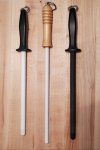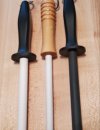Hello,
I am shopping for a good ceramic rod for honing instead of steel and I want a good one which will last. I found Green Elephant:
https://www.amazon.com/gp/product/B019MQCDZW/ref=ask_ql_qh_dp_hza
which claims: "DURABILITY with the highest quality ceramic available on the market – hardness of this ceramic sharpening steel is 9 Mohs (SGS tested). Rockwell hardness over 100 (Yes, that's correct)"
Alternative is Boker 09SR001 Sieger Long Life Knife Sharpener which claims:
"Hardened to roughly 200RC the synthetic ruby Seiger Long Life 20 will help keep your cutting edges their keenest."
I am not planning to use knives harder than 62. Green Elephant is half the price. Will i get substantial advantages of using harder honing steel or everything what is harder than my knives will work the same?
I am shopping for a good ceramic rod for honing instead of steel and I want a good one which will last. I found Green Elephant:
https://www.amazon.com/gp/product/B019MQCDZW/ref=ask_ql_qh_dp_hza
which claims: "DURABILITY with the highest quality ceramic available on the market – hardness of this ceramic sharpening steel is 9 Mohs (SGS tested). Rockwell hardness over 100 (Yes, that's correct)"
Alternative is Boker 09SR001 Sieger Long Life Knife Sharpener which claims:
"Hardened to roughly 200RC the synthetic ruby Seiger Long Life 20 will help keep your cutting edges their keenest."
I am not planning to use knives harder than 62. Green Elephant is half the price. Will i get substantial advantages of using harder honing steel or everything what is harder than my knives will work the same?


